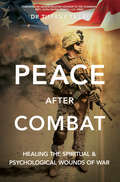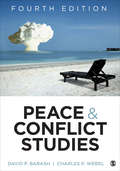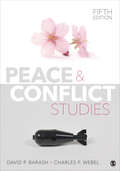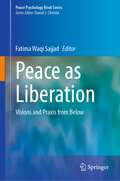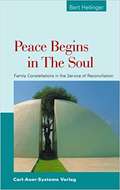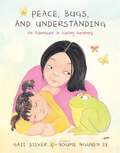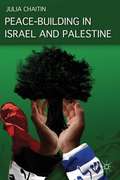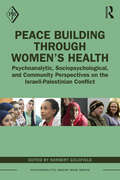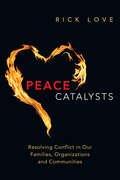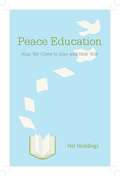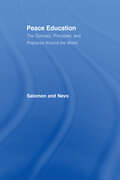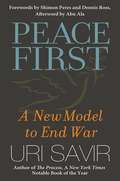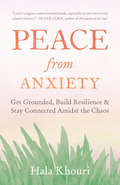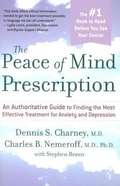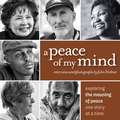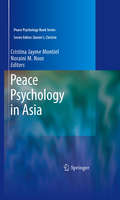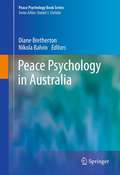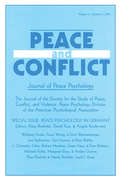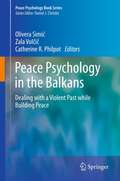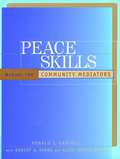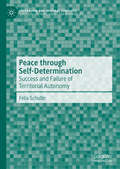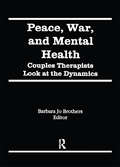- Table View
- List View
Peace after Combat: Healing the Spiritual and Psychological Wounds of War
by Dr. Tiffany TajiriIt could be your neighbor, your coworker, your son, or the woman sitting next to you in church. When combat veterans return from war, they&’re often confused. They struggle to reconnect with their families; the cheering crowds and smothering hugs make them want to jump out of their skin; and sometimes they even long to return to the hell of deployment. What they&’ve experienced in combat can radically change how they view themselves, others, and the world at large. They may have never seen so much hurt, suffering, death, and destruction, which leaves them questioning, &“Where is God?&” Dr. Tiffany Tajiri, a veteran USAF officer and board-certified clinical psychologist, has been in countless sessions with combat veterans and their loved ones and now shares powerful first-hand accounts, lessons, proven exercises, and biblical truth. Whether experiencing combat directly as a veteran or wanting to help bring healing as a family member, pastor, chaplain, or counselor, this book is essential. The emotional, psychological, and spiritual healing encountered applies to anyone facing harsh realities and uncomfortable questions and hoping to find peace again.
Peace and Conflict Studies (Conflict And Consciousness Ser. #Vol. 9)
by David P. Barash Charles P. WebelThe thoroughly updated Fourth Edition of the gold standard text explores historical and current topics in today’s rapidly changing world to provide a comprehensive introduction to peace and conflict studies. Authors David P. Barash and Charles P. Webel offer an insightful analysis of 21st-century global affairs, including such timely topics as ISIS, the nature of violence and nonviolence, cutting-edge military technologies, the Terrorism and Global Peace Indexes, and the latest developments in Iran, North Korea, and Syria. Comprehensive yet written in a student-friendly and accessible style, the text represents a commitment to inspire readers to create a better world through an understanding of what has happened and what is happening, and therefore what is likely to take place in the future.
Peace and Conflict Studies
by David P. Barash Charles P. WebelThe thoroughly updated Fourth Edition of the gold standard text explores historical and current topics in today’s rapidly changing world to provide a comprehensive introduction to peace and conflict studies. Authors David P. Barash and Charles P. Webel offer an insightful analysis of 21st-century global affairs, including such timely topics as ISIS, the nature of violence and nonviolence, cutting-edge military technologies, the Terrorism and Global Peace Indexes, and the latest developments in Iran, North Korea, and Syria. Comprehensive yet written in a student-friendly and accessible style, the text represents a commitment to inspire readers to create a better world through an understanding of what has happened and what is happening, and therefore what is likely to take place in the future.
Peace and Conflict Studies
by David P. Barash Charles P. WebelPeace and Conflict Studies sets the standard for an accessible introduction, a comprehensive exploration, and analysis of 21st-century world events – including updated coverage of the COVID-19 pandemic, the Middle East, the Social Justice movements within the US, and Global Climate Change. The text examines current conflicts, explores the important aspects of positive peace, individual violence, nationalism, and terrorism, provides numerous visual aids, questions for further study, and suggested readings, and furnishes a comprehensive range of material to enlighten and enrich future discussion and encourage further academic pursuit. With a broad and authoritative scope, this introductory text chronicles a plethora of important global topics from pre-history to the present.
Peace and Conflict Studies
by David P. Barash Charles P. WebelPeace and Conflict Studies sets the standard for an accessible introduction, a comprehensive exploration, and analysis of 21st-century world events – including updated coverage of the COVID-19 pandemic, the Middle East, the Social Justice movements within the US, and Global Climate Change. The text examines current conflicts, explores the important aspects of positive peace, individual violence, nationalism, and terrorism, provides numerous visual aids, questions for further study, and suggested readings, and furnishes a comprehensive range of material to enlighten and enrich future discussion and encourage further academic pursuit. With a broad and authoritative scope, this introductory text chronicles a plethora of important global topics from pre-history to the present.
Peace as Liberation: Visions and Praxis from Below (Peace Psychology Book Series)
by Fatima Waqi SajjadThis edited volume highlights a type of violence largely overlooked by peace psychologists; it explores ‘epistemic violence’ which refers to the silencing of the marginalized, racialized and colonized people in the process of knowledge production. This book celebrates the voices and the agency of the subalterns, honoring their visions, testimonies and struggles to push boundaries and create spaces for peace within oppressive environments. “Visions and Praxis from below” refers to peace visions and struggles of the people who live “below the vital ability of shaping the world according to their own vision”. It is a challenge to the hegemonic perspective that ‘credible’ thinking on peace can only be done by the people ‘from above’. This perspective will add to the understanding of not only peace psychologists, but all those who work toward social justice.
Peace Begins in the Soul: Family Constellations in the Service of Reconciliation
by Bert Hellinger Colleen BeaumontIn family constellations, the work of reconciliation begins in the individual soul and in the family. When reconciliation is achieved there, it can spread to larger groups and contexts. In this book, Bert Hellinger inquires into the emotional prerequisites that are necessary for peace and reconciliation. He finds answers in examples from historic conflicts between peoples and cultures. But Hellinger also devotes himself to peace among religions, for example, between Christianity and Islam, as well as to peace between victors and vanquished in the Spanish Conquest, and between masters and slaves in Brazil or the United States.
Peace, Bugs, and Understanding: An Adventure in Sibling Harmony (Anh's Anger Story)
by Gail Silver Youme Nguy?n LyLily and her little sister Ruby are having a picnic when Ruby spoils their game of checkers. Lily lashes out but soon gets absorbed in a wonderful book, the story of her great grandfather's encounter with a strange looking frog-like creature called Anger. The precious old journal teaches Lily about Metta, a technique that has helped people transform anger into loving kindness for thousands of years.With original watercolors by award-winning illustrator Youme Nguyen Ly, Peace, Bugs, and Understanding is an invaluable tool for parents and teachers, and will help children learn to understand the causes of their own strong emotions, while teaching them peaceful ways to resolve difficulties through mindfulness and meditation. and accepting accountability for their actions when appropriate. By learning these skills, children can grow comfortable with them and carry them into adulthood with ease and confidence.
Peace-Building in Israel and Palestine
by Julia ChaitinThis book presents an overview of psycho-social research on the Israeli-Palestinian conflict, presents and analyzes people-to-people activities in the region, and offers new conceptualizations for Israeli-Palestinian co-creation of a grassroots peace and social justice processes.
Peace Building Through Women’s Health: Psychoanalytic, Sociopsychological, and Community Perspectives on the Israeli-Palestinian Conflict (Psychoanalytic Inquiry Book Series)
by Norbert GoldfieldThis book is an examination of the Israeli-Palestinian conflict through psychoanalytic, sociopsychological, and nationalistic lenses, highlighting the successes and the hurdles faced by one organization, Healing Across the Divides (HATD), in its mission to measurably improve health in marginalized populations of both Israelis and Palestinians. Peace Building through Women’s Health begins with a summary of the "peace building through health" field and a psychoanalytic, sociopsychological examination of the Israeli-Palestinian conflict. After a series of informative case studies, the book concludes with an analysis of how this organization has evolved its "peace building through health" approach over the fifteen years since its founding. Working with community groups, HATD has measurably improved the lives of more than 200,000 marginalized Israelis and Palestinians. In the process, it also improves the effectiveness of the community group grantees, by offering experienced management consulting and by requiring rigorous ongoing self-assessment on the part of the groups. IHATD hopes that, in the long term, some of the community leaders it supports will be tomorrow’s political leaders. As these leaders strengthen their own capabilities, they will be able to increasingly contribute to securing peace in one of the longest running conflicts in the world today. Peace Building through Women’s Health will be invaluable to public and mental health professionals interested in international health, peace and conflict studies, and conflict resolution.
Peace Catalysts: Resolving Conflict in Our Families, Organizations and Communities
by Rick Love"If it is possible, as far as it depends on you, live at peace with everyone." —Romans 12:18 Conflict happens. It's a painful reality of life in a fallen world. But we don't need to be content with broken relationships—conflict resolution is possible. God's intention for us and for the world is for all to live in peace with one another, and Christian peacemakers have an unparalleled opportunity to be true ambassadors of reconciliation. Rick Love, founder and president of Peace Catalyst International, shares the principles that have guided his peacemaking efforts around the world. Masterfully blending Scripture and personal experience, he provides a biblical framework for how the God of peace seeks restoration for all who experience conflict—in the home and workplace and even across international borders. With the life of Jesus as the prime example, Love equips and empowers peacemakers of all stripes to integrate evangelical witness with commitment to reconciliation. We can walk in the footsteps of Jesus as catalysts of peace, bringing transformation and hope to a world crying out for healing and forgiveness.
Peace Education: How We Come to Love and Hate War
by Nel NoddingsThere is a huge volume of work on war and its causes, most of which treats its political and economic roots. In Peace Education: How We Come to Love and Hate War, Nel Noddings explores the psychological factors that support war: nationalism, hatred, delight in spectacles, masculinity, religious extremism and the search for existential meaning. She argues that while schools can do little to reduce the economic and political causes, they can do much to moderate the psychological factors that promote violence by helping students understand the forces that manipulate them.
Peace Education: The Concept, Principles, and Practices Around the World
by Gavriel Salomon Baruch NevoPeace Education: * presents views on the nature of peace education, its history, and relationships to neighboring fields; * examines relevant psychological and pedagogical principles, such as the contact experience, conciliation through personal story telling, reckoning with traumatic memories, body-work, and the socio-emotional aspects of reconciliation; and * introduces an array of international examples from countries, such as Croatia, Northern Ireland, Israel, South Africa, Rwanda, and the United States in order to generalize lessons learned. A "must have" for all those thinking, planning, conducting, and studying peace education programs, it is intended for scholars, students, and researchers interested in peace and conflict resolution in higher education and volunteer and public organizations. Its cross disciplinary approach will appeal to those in social and political psychology, communication, education, religion, political science, sociology, and philosophy.
Peace First: A New Model to End War
by Uri SavirPeace First draws on Savir's own deep, first-hand experiences from the Oslo Peace Process, as well as his peace-building efforts between enemies and former enemies in the African nations of Ethiopia, Eritrea, Rwanda, and Sierra Leone.
Peace from Anxiety: Get Grounded, Build Resilience, and Stay Connected Amidst the Chaos
by Hala KhouriA holistic approach to easing anxiety without hiding from the world's challenges.Overwhelming anxiety and stress--most of us experience these feelings at some point. The challenges in our lives threaten to overpower us at times and the struggles we see in the world further add to the burden. Peace from Anxiety helps us understand the deep roots of our suffering so that we can work toward finding more peace--even in chaos. Therapist and yoga teacher Hala Khouri takes us on a journey to investigate our personal habits, understand our lives, and transform what doesn't serve us. Even though the roots of our anxiety, stress, and pain may feel complicated, healing doesn't have to be.Khouri explores how our brain and nervous system experience stress and discusses how we can begin to get in touch with our body to better understand its signals and how to handle them. She delves deeply into the primary causes of anxiety and offers practical tools for releasing stress and being present with discomfort. Peace from Anxiety discusses topics including trauma, relationships, technology, and working not only for individual healing but also collective healing in our world. Filled with relatable stories and examples, each chapter offers a range of practices and tools to help us find more peace and work for good in our own lives and the lives of others.
Peace from Nervous Suffering
by Claire WeekesThis classic anxiety-relief guide from the author of Hope and Help for your Nerves has brought solace to over a quarter million readers coping with panic attacks and agoraphobia. Dr Claire Weekes offers clear, concise advice to anyone suffering from anxiety: FACE: DO NOT RUN ACCEPT: DO NOT FIGHT FLOAT PAST: DO NOT LISTEN IN LET TIME PASS: DO NOT BE IMPATIENT WITH TIME It may look much too simple, but if you can truly master these four important principles, you are already on your way to rapid recovery. Written in response to great demand from both the medical and psychological communities, as well as from her own devoted readers, Dr. Weekes's revolutionary approach to treating nervous tension is sympathetic, medically sound, and quite possibly one of the most successful step-by-step guides to mental health available.
The Peace of Mind Prescription
by Dennis S. CharneyThe Ultimate Guide to Identifying, Treating, and Overcoming Depression and Anxiety Two world-renowned psychiatrists have created a comprehensive and empowering guide to the science and treatment of anxiety and depression. At the heart of their message is the idea that treatment can and must be tailored to the individual and that armed with the right information, patients can get the support they need from their health-care providers. Practical and authoritative, The Peace of Mind Prescription has been unanimously praised as a valuable resource that offers hope to millions of sufferers. Dennis S. Charney, M. D. , is the Dean of Research and the Anne and Joel Ehrenkranz Professor in the departments of psychiatry, neuroscience, and pharmacology and biochemistry at the Mount Sinai School of Medicine. Charles B. Nemeroff, M. D. , Ph. D. , is the Reunette W. Harris Professor and chairman of the department of psychiatry and behavioral sciences at Emory University's School of Medicine.
A Peace of My Mind: Exploring The Meaning of Peace One Story at a Time
by John NoltnerThis book is a collection of diverse experiences of people from many different parts of the world filled with revelations of courage,commitment, resilience and hope.
Peace Psychology in Asia
by Noraini M. Noor Cristina Jayme MontielIn recent years, peace psychology has grown from a utopian idea to a means of transforming societies worldwide. Yet at the same time peacebuilding enjoys global appeal, the diversity of nations and regions demands interventions reflecting local cultures and realities. Peace Psychology in Asia shows this process in action, emphasizing concepts and methods diverging from those common to the US and Europe. Using examples from China, India, Indonesia, the Philippines, and elsewhere in the region, chapter authors illuminate the complex social, political, and religious conditions that have fostered war, colonialism, dictatorships, and ethnic strife, and the equally intricate personal and collective psychologies that need to be developed to encourage reconciliation, forgiveness, justice, and community. Peace Psychology in Asia: Integrates psychology, history, political science, and local culture into concepts of peace and reconciliation. Highlights the indigenous aspects of peace psychology. Explains the critical relevance of local culture and history in peace work. Blends innovative theoretical material with empirical evidence supporting peace interventions. Balances its coverage among local, national, regional, and global contexts. Analyzes the potential of Asia as a model for world peace. As practice-driven as it is intellectually stimulating, Peace Psychology in Asia is vital reading for social and community psychologists, policy analysts, and researchers in psychology and sociology and international studies, including those looking to the region for ideas on peace work in non-Western countries.
Peace Psychology in Australia
by Nikola Balvin Diane BrethertonThis book is a case study of the development of peace psychology in Australia. While there is, in comparison to other countries, relatively little overt violence, Australia the nation was founded on the dispossession of Indigenous people, and their oppression continues today. Peace Psychology in Australia covers the most significant issues of peace and conflict in the country. It begins with a review of conflict resolution practices among Australia's ancient Indigenous cultures and succinctly captures topics of peace and conflict which the country has faced in the past 222 years since British settlement. The fast population growth, thriving multiculturalism, leadership in international affairs and environmental isolation make Australia a microcosm for the study of human conflicts and peace movements.
Peace Psychology in Germany: A Special Issue of Peace and Conflict
by Klaus Boehnke Daniel Fuss Angela KindervaterFirst published in 2005. This is a special issue of Peace and Conflict, the Journal of Peace Psychology, Volume II, number 3 looks at Peace Psychology in Germany. The papers include old and new antisemitic attitudes, human rights, attitudes towards War, refugees, and results from a German Six-Wave, twenty-year study.
Peace Psychology in the Balkans
by Catherine R. Philpot Olivera Simić Zala VolčičThe volume covers the development of peace psychology in the Balkans. The Balkans is a region marked by post-communist and post-conflict transitional turmoil, and this book provides a comprehensive introduction to research in peace psychology in this part of the world, written by scholars primarily working in the Balkan area. It brings together innovative scholarship that examines interdisciplinary aspects of peace psychology researched and written by scholars from Kosovo, Serbia, Bosnia, Bulgaria, Romania, Macedonia, Croatia, and Slovenia as well as presenting research that responds to contemporary global issues by tracking the ways in which peace psychology is developing and implementing in the Balkans.
Peace Skills: Manual for Community Mediators
by Ronald Kraybill Alice Evans Robert EvansHow to be a "peacebuilder" and mediate between conflicted entities.
Peace through Self-Determination: Success and Failure of Territorial Autonomy (Federalism and Internal Conflicts)
by Felix SchulteBringing together comparative politics, conflict research and social psychology, this book presents a novel theory to explain the consolidation outcomes of post-conflict autonomy arrangements. It builds on Social Identity Theory and identifies a successful process of ethnic recognition as the key prerequisite for peaceful interethnic cohabitation through territorial self-governance. As this process is highly context-dependent, the study identifies relevant structural and actor-centered factors and analyzes their occurrence in the consolidation periods of nineteen autonomy arrangements worldwide using Qualitative Comparative Analysis (QCA). The author concludes that elites accept autonomy reforms if they promise a high degree of self-determination and, at the same time, ethnic recognition is not hindered by horizontal inequalities. Bargaining efforts succeed within inclusive institutions involving non-nationalist parties and international organizations. Autonomy reforms fail if the degree of self-rule offered is too low and strong inequalities generate new grievances. Autocratic rule, nationalist parties, and a lack of international attention provide a breeding ground for further centrifugal activities. In-depth case studies on South Tyrol and the Chittagong Hill Tracts provide further evidence for the theoretical models.
Peace, War, and Mental Health: Couples Therapists Look at the Dynamics
by Barbara Jo BrothersDiscover how issues of world war and peace relate to the dynamics of couples therapy in this thought-provoking book. In Peace, War, and Mental Health, couples therapists provide diverse views on the links between strengthening marriages and preventing and solving international disputes. Although the contributors vary in their approaches to this issue, a common theme is the belief that couples as well as countries need to build bridges, not walls, for healthy relationships and they need to strive to learn what others are really feeling, thinking, or needing underneath the defenses others exhibit.The contributing therapists in Peace, War, and Mental Health explore the various links between couples in conflict and nations at war. Chapters describe how prevention strategies used for couples in therapy may be applied to the well-being of the world as a whole and how significant change is possible through the involvement of only a small percentage of the population. Other chapters focus on specific tools for couples therapy such as outlines of the major tasks of relationship building and traps that mitigate against good relationship construction, a description of the nuts and bolts of conflict resolution, and the use of flashcards to help both members of the pair present his or her real feelings to the other. Some of the intriguing topics covered in this book include: the relationship between psychotherapy and spirituality and the paradox of individuals longing to belong since each is a part of the whole the role of gender on war and its potential impact on peace the failure of the humanistic movement societal attitudes linking domestic violence and large scale violence how the potential for resolution of differences in couples can be applied to peace among nations how prevention may be expanded to include the “mental health” of the whole world--Part V of an interview with Virginia SatirPeace, War, and Mental Health helps therapists look at international peace and couples therapy with new perspectives, a necessity in today’s rapidly changing family and world climate.
